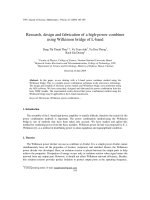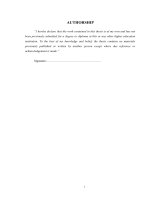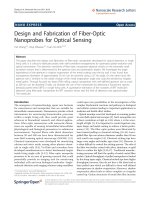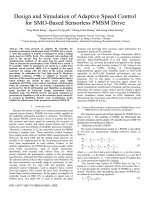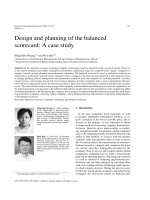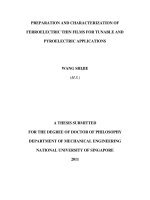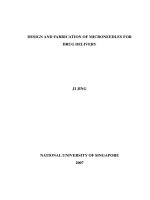Design and fabrication of ferroelectric thin film based microwave miniature tunable devices
Bạn đang xem bản rút gọn của tài liệu. Xem và tải ngay bản đầy đủ của tài liệu tại đây (1001.14 KB, 134 trang )
Design and Fabrication of
Ferroelectric Thin Film based
Microwave Miniature Tunable
Devices
Zhou Linlin
(B. Sc., Dalian University of Technology, PRC)
A THESIS SUBMITTED FOR THE
DEGREE OF MASTER
DEPARTMENT OF PHYSICS
NATIONAL UNIVERSITY OF SINGAPORE
2009
Acknowledgements
I would like to foremost thank my supervisor Professor Ong Chong Kim for his
continuous guidance and support during my studies. I am grateful to him for accepting
me as a member of his research centre, Centre for Superconducting and Magnetic
Materials (CSMM). He has been very involved with my research and provided great
helps. I benefited a lot from his deep knowledge during my research.
I also like to thank Dr. Wang Peng for his introduction to microwave theory and
computer simulation of microwave devices, as well as his help for advices and
discussions. I am grateful for Mr. Cheng Weining for his introduction to pulsed laser
deposition and RF sputtering techniques; Dr. Wang Peng for his introduction of
lithography and wet etching; Miss Song Qing for her introduction of X-ray diffraction,
scanning electron microscope and target preparation.
I would also like to thank my friends at CSMM, Miss Song Qing, Miss Lim Siewleng,
Miss Phua Lixian, Dr. Liu Yan, Dr. Liu Huajin and Dr. Wang Peng, with them my
graduate life is enrich and happy.
Finally, I want to thank my parents for their endless support and love.
This research is partly supported by Agency for Science, Technology and Research.
i
Table of contents
Contents
Pages
Acknowledgement …………………………………………………………………i
Table of contents…………………………………………………………………...ii
Summary…………………………………………………………………………...vi
List of figures……………………………………………………………………..viii
Chapter1
Introduction …………………………………………………………...1
1.1
Microwave tunable devices and tuning technologies………………….1
1.2
Ferroelectric thin film and its varactors………………………………..2
1.2.1
Non-linear dependence of polarization on applied
electric field of ferroelectric material…………………………3
1.2.2
Ferroelectric thin film varactors ……………………………...8
1.2.2.1 Basic structures of varactors…………………………9
1.2.2.2 Dielectric properties and quality of ferroelectric
thin film……………………………………………..11
1.2.2.3 Barium strontium titanate ferroelectric thin film…...13
1.2.2.4 Bismuth Zinc Niobate thin film as alternative
candidate of tuning materials ………………………13
1.2.2.5 Conductor layer and conducting loss……………….14
1.3
Scope and outline of this study……………………………………….15
References
Chapter2
Fabrication of thin films and conducting layers………………………24
ii
2.1
Pulsed laser deposition of Barium strontium titanate and
Bismuth zinc niobate thin films……………………………………….24
2.1.1
Target preparation …………………………………………...24
2.1.2
Introduction to pulsed laser deposition system………………25
2.1.3
Deposition parameters for Ba 0.5 Sr0.5TiO 3 and
Bi1.5 Zn1.0 Nb1.5 O7 thin films …………………………………..27
2.2
2.3
Preparation of conducting layer ……………………………………...28
2.2.1
RF sputtering of thin Au/Cr seed layer……………………...28
2.2.2
Electroplating of thick gold layer…………………………...29
Lift-off method for fabrication of patterned Ba 0.5 Sr0.5TiO 3
thin films……………………………………………………………...29
2.3.1
Chapter3
Fabrication of patterned Ba 0.5 Sr0.5TiO 3 thin film……………..30
Microwave tunable coupled microstrip open-loop resonators
bandpass filter with Ba 0.5 Sr0.5TiO 3 thin film varactors……………….34
3.1
Introduction to design of microwave filter…………………………...34
3.2
Filter design…………………………………………………………..39
3.2.1
Low-pass prototype and calculation of coupling
coefficients………………………………………………….39
3.2.2
Half-wavelength open-loop resonator………………………40
3.2.3
Coupled feedline and external quality factor………………..43
3.2.4
Coupling of resonators and coupling coefficient……………49
3.3
Fabrication of filter…………………………………………………...54
3.3
Measurement results and discussion………………………………….56
3.4
Summary……………………………………………………………...60
iii
References
Chapter4
Microwave tunable coupled microstrip lines phase shifter
with Ba 0.5 Sr0.5TiO3 thin film varactors ……………………………….65
4.1
Properties of coupled microstrip lines ………………………………65
4.2
Odd mode excitation of balun circuit………………………………..69
4.3
Phase shifter design………………………………………………….70
4.3.1
Calculation of phase shift and tenability…………………...70
4.3.2
HFSS simulator optimization of phase shifter……………...74
4.4
Fabrication of phase shifter…………………………………………..82
4.5
Measurement results and discussion…………………………………82
4.6
Summary……………………………………………………………...85
References
Chapter5
Bismuth zinc niobate thin film and its varactors……………………..88
5.1
Introduction to Bi1.5 Zn1.0 Nb1.5 O7 thin film……………………………88
5.2
Crystalline structure and morphology of Bi1.5 Zn1.0 Nb1.5 O7
thin films...............................................................................................90
5.3
5.2.1
Crystallization of Bi1.5 Zn1.0 Nb1.5 O7 thin films………………90
5.2.2
Morphology of Bi1.5 Zn1.0 Nb1.5 O7 thin films ………………...92
Dielectric properties of Bi1.5 Zn1.0 Nb1.5 O7 thin films and their
varactors…………………………………………………………….. .93
5.3.1
Fabrications of Bi1.5 Zn1.0 Nb1.5 O7 thin film varactors………..93
5.3.2
Microwave dielectric properties characterization…………...97
5.3.2.1
Performance of varactors…………………………99
iv
5.3.2.2
Dielectric response of Bi1.5 Zn1.0 Nb1.5 O7
thin films…………………………………………108
5.4
Summary …………………………………………………………...115
References
Chapter6
Conclusion…………………………………………………………..119
v
Summary
This study presents a research effort for implementation of room temperature
microwave planar tunable filter and phase shifter with barium strontium titanate thin
film varactors, as well as characterization of bismuth zinc niobate thin film at
microwave frequency for tunable devices applications.
For room temperature operation of the filter and phase shifter, Ba 0.5 Sr0.5TiO 3 thin film
varactors and gold strips are chosen. Ba 0.5 Sr0.5TiO 3 thin film has a Curie temperature
around room temperature, where high relative permittivity and tunability exist. Thin
films are patterned instead of whole plate one, together with high conductivity gold
conducting layer, to decrease both the dielectric loss and ohmic loss in the
devices. Ba 0.5 Sr0.5TiO 3 thin films as well as Bi1.5 Zn1.0 Nb1.5 O7 thin films are deposited
by pulsed laser deposition method, gold conducting layer are grown by RF sputtering
and electroplating methods.
The tunable band-pass filter is based on the coupling of microstrip open-loop
resonators with Ba 0.5 Sr0.5TiO 3 thin film planar varactors on LaAlO 3 (LAO) substrate.
The extract of external quality factor and coupling coefficient are studied by full wave
electromagnetic simulation. The effects of spacing between resonator at input/output
and feed line on the external quality factor as well as the spacing between adjacent
resonators on coupling coefficient are discussed. The fabricated filter is measured
using vector network analysis (VNA) equipment and the experimental results are
compared with its high temperature superconductor (HTS) counterpart.
vi
The phase shifter is designed to consist of high impedance coupled microstrip lines
periodically loaded with Ba 0.5 Sr0.5TiO 3 thin films planar varactors on LAO substrate.
The balun circuit used to provide odd mode excitation to coupled microstrip lines and
also as an impedance matching network is discussed. Expression of the tunability of
the phase shifter is deduced to find out factors affecting the tunability. Full wave
electromagnetic simulation is performed to study the effects of strip width as well
spacing between strips of the coupled microstrip lines and the quarter wavelength
lines in the balun circuit on these factors and maximize the tunability. During
optimization of phase shifter, impedance matching should also be maintained by
examining the dimension of balun circuit. The experimental results of the fabricated
phase shifter agree well with the analysis
At last, characterization of Bi1.5 Zn1.0 Nb1.5 O7 thin film as alternative tuning material is
performed. Thin films are deposited on platinum coated silicon (Pt/Si) and single
crystal LAO, respectively. Crystallization and morphology of thin films are studied by
X-ray diffraction and scanning electron microscope. Microwave permittivity
characterization is performed at room temperature based on the parallel plate varactor
on Pt/Si and planar plate interdigital varactor on LAO substrates. The impedance of
the varactor under test is extracted by one-port reflection measurement using VNA
equipment. Experimental results of dielectric properties of these two varactors and
thin films prove the feasibility of application of Bi1.5 Zn1.0 Nb1.5 O7 thin film into
microwave tunable devices.
vii
List of Figures
Figure Captions
Pages
Figure1.1.Polarization-Electric field curves of ferroelectric material
at (a) ferroelectric phase and (b) paraelectric phase………………...4
Figure1.2. A typical relative permittivity ε r' vs. bias electric field
characteristics of a ferroelectric material. The relative
permittivity and bias electric field are normalized to
their maximum values, respectively………………………………..6
Figure1.3. Layout of planar plate varactor (a) side view and (c) 3D view;
parallel plate varactor (b) side view and (d) 3D view……………….9
Figure2.1. a schematic diagram of PLD system……………………………....25
Figure2.2. Side view of (a) whole plate and (b) patterned Ba 0.5 Sr0.5TiO 3
thin film…………………………………………………………....30
Figure2.3. Fabrication process flow for patterned Ba 0.5 Sr0.5TiO 3 thin film…..32
Figure3.1. (a) Low-pass prototype filter (b) Band-pass filter transformed
from the low-pass prototype……………………………………….36
Figure3.2. General microstrip structure ……………………………………....41
Figure3.3. Dimension of the open-loop resonator with unit mm……………..42
Figure3.4. Sideview of the planar Ba 0.5 Sr0.5TiO 3 varactor on
LAO substrate……………………………………………………...43
viii
Figure3.5. (a) tapped line and (b) coupled line structures for input/output
Coupling……………………………………………………………44
Figure3.6. Transmission scattering parameter of a typical resonator…………46
Figure3.7. Dependence of external quality factor on the spacing between
feedline and resonator………………………………………………47
Figure3.8. Layout of open-loop resonator……………………………………..48
Figure3.9. Simulation result of open-loop resonator. Pink color curve
represents transmission scattering parameter and blue color
curve reflection scattering parameter………………………………49
Figure3.10. (a) Electric coupling structure (b) Magnetic coupling structure
(c) and (d) Mix coupling structure ………………………………..50
Figure3.11. Resonant mode splitting of three types of coupled open-loop
Resonators…………………………………………………………52
Figure3.12. Layout of the tunable bandpass filter. Black area represents the
regions with gold; grey area represents the regions with
Ba 0.5 Sr0.5TiO 3 thin film……………………………………………53
Figure3.13. The simulation results of the tunable bandpass filter. Curve of
blue color represents S11 parameter and curve of pink color
represents S 21 parameter…………………………………………..54
Figure3.14 Fabrication process flow for metal layer of filter………………….55
Figure3.15. Scattering matrix measured for the filter. (a) Comparison of
modeled and measured data (b) Insertion loss versus bias
voltage (c) Return loss versus bias voltage………………………..57
ix
Figure4.1. Cross section of coupled microstrip lines…………………………..66
Figure4.2. Quasi-TEM modes of a pair of coupled microstrip lines:
(a) odd mode (b) even mode ………………………………………..67
Figure4.3. (a) Schematic layout of a planar Marchand balun (b) microstrip
implementation of the balun…………………………………………70
Figure4.4.Schematic structure of a CM phase shifter periodically loaded with
Ba 0.5 Sr0.5TiO3 thin film varactors and its circuit approximation
(a) schematic layout (b) equivalent circuit of coupled lines before
loaded with varactors (c) after loaded with varactors ………………..72
Figure4.5. Simulated relationship between propagation constant and
(a) width of unloaded CM lines (b) gap between unloaded
CM lines………………………………………………………………75
Figure4.6. Simulation of the changing of unloaded CM lines odd mode
impedance with (a) strip width of CM lines (b) gap between
CM lines……………………………………………………………..77
Figure4.7. Simulation result of the relationship between odd mode
impedance of the loaded CM lines and (a) strip width of balun
(b) gap between strips in balun………………………………………79
Figure4.8. (a) Simulation result of the modeled phase shifter without balun
circuit, solid line represents transmission scattering papameter,
dashed line represents reflection scattering parameter (b) layout
of the phase shifter with dimension unit um………………………...81
Figure4.9. Measured scattering parameters (a) insertion loss (b) return loss
(c)differential phase shift of the coupled microstrip lines phase
x
shifter with frequency ………………………………………………..84
Figure5.1. XRD patterns of Bi1.5 Zn1.0 Nb1.5 O7 films on Pt/Si and LAO
substrates…………………………………………………………….91
Figure5.2. SEM cross-section and surface morphologies of Bi1.5 Zn1.0 Nb1.5 O7
thin films on (a) LAO and (b) Pt/Si substrates………………………92
Figure5.3. Fabrication process flow of Bi1.5 Zn1.0 Nb1.5 O7 thin film
(a) parallel plate varactor on Pt/Si substrate and (b) planar
plate interdigital varactor on LAO substrate…………………………94
Figure5.4. Patterns of Bi1.5 Zn1.0 Nb1.5 O7 thin film varactors on Pt/Si substrate
(a) top view and (b) side view; on LAO substrate (c) top view and
(d) side view …………………………………………………………..96
Figure5.5. Measurement setup for Bi1.5 Zn1.0 Nb1.5 O7 thin film (a) parallel
plate and (b) interdigital varactors……………………………………98
Figure5.6. Equivalent circuit of BZN thin film parallel plate varactor
including inner circle and outer circle capacitors…………………….100
Figure5.7. Measured zero-bias capacitance and loss tangent of
Bi1.5 Zn1.0 Nb1.5 O7 thin film parallel plate and interdigital
varactors at room temperature………………………………………..101
Figure5.8. a schematic graph of electric field distribution of parallel plate
varactor with (a) perfect conductivity and (b) finite conductivity
bottom electrode……………………………………………………...103
Figure5.9. A simplified equivalent circuit of the parallel plate varactor
on Pt/Si subtrate………………………………………………………103
xi
Figure5.10. Loss tangent of Bi1.5 Zn1.0 Nb1.5 O7 thin film parallel plate
varactor with two sizes of electrodes……………………………..105
Figure5.11. Relative permittivity and loss tangent of Bi1.5 Zn1.0 Nb1.5 O7
thin films on Pt/Si and LAO measured at zero and none-zero
bias states…………………………………………………………112
Figure5.12. Bias electric field dependence of normalized relative
permittivity of Bi1.5 Zn1.0 Nb1.5 O7 thin films on Pt/Si and
LAO substrates measured at 1GHz……………………………….113
xii
Chapter1:
Introduction
1.1 Microwave tunable devices and tuning technologies
Microwave tunable devices mainly include resonators, filters, phase shifters, delay
lines, matching circuits, power dividers and oscillators, etc and have applications in
both commercial and military communication and radar systems.
Many mechanisms are used to produce tunable microwave devices including ferrite,
Micro electromechanical systems (MEMS), semiconductor, ferroelectrics, etc [13].Ferrite phase shifters technology has been largely employed in military systems.
However, they require strong magnetic fields, which will be power consuming.
Besides, ferrite phase shifters are slow and can not be used in application where rapid
response is required. Semiconductors are promising in terms of integration
possibilities, high tunability and much faster response speed. However, the linear
decrease of the quality factor with frequency is the main disadvantage for high
frequency above 20GHz applications. Traditional mechanically tunable microwave
components are slow and bulky. MEMS varactors are small, low loss and most
important, have very high quality factor value. However, the tuning speed and high
operating voltage remain issues [4-5].
Ferroelectric materials are of great interest owing to their properties of non-linear
relationship between relative permittivity and applied bias electric field, which results
in an ability to control their relative permittivity by applying bias electric field. Due to
1
the high relative permittivity, the sizes of tunable devices based on ferroelectrics are
usually small. The breakdown strength of these materials is sufficiently high, so
ferroelectric components have high tunability, for thin film parallel plate varactors the
tunability can be up to 50%. Ferroelectric device have low power consumption and
fast tuning speed of less than 1.0ns. These properties of ferroelectric materials make
them promising candidates as tuning elements [6-11].
1.2 Ferroelectric thin film and its varactors
Ferroelectrics are important components in a wide spectrum of applications including
microsystems, high frequency electrical components, and memories. Application of
ferroelectrics to microwave devices began in 1960s [12-16]. At that time, bulk
ferroelectrics suffered from the high bias voltage needed for efficient tuning, which
usually of the order of hundreds of volts to tens of kilovolts. The investigation of thin
film ferroelectric started at the late 1960s and early 1970s for fabrication of memories.
However, difficulties with materials processing frustrated their practical applications.
Until in 1980s the advances in processing of complex ferroelectric oxide and
monolithically compatible processing of ferroelectric thin-film compounds, thin film
ferroelectric materials were inspired wide investigation instead of bulk forms taking
the advantages of small tuning voltage needed for a required tunability, the potential
to produce microwave integrated circuits in one technological cycle to reduce
production costs, further miniaturization of devices, and the possibility to integrate
with micro electronic circuits [17-19].
2
1.2.1 Non-linear dependence of polarization on an applied electric field of
ferroelectric material
In general, ferroelectrics are a class of materials possessing a spontaneous electric
polarization. The spontaneous electrical polarization of ferroelectric materials is due
to electric dipoles. At a certain temperature range, the centers of the positive and
negative charges in a crystal of such a material become displaced even without an
external applied electric field. Groups of dipoles tend to align in the same direction
instead of random arrangement, which will form a spontaneous polarization domain,
to minimize energy. In experiment, spontaneous polarization of ferroelectrics implies
a hysteresis loop in the response of polarization to an external electric field as shown
in figure1.1.
(a)
3
(b)
Figure1.1. Polarization-Electric field curves of ferroelectric material at (a)
ferroelectric phase and (b) paraelectric phase.
The material relative permittivity ε r is a complex quantity:
ε r = ε r' − jε r'' = Re(ε r ) − Im(ε r )
(1.1)
By definition, the real part of the relative permittivity ε r' of ferroelectrics is
proportional to the ratio of the electric polarization to applied electric field strength,
which is corresponding to the slope of the P-E curve shown in figure1.1. This nonlinear polarization for ferroelectric materials is the origin of the changing of relative
permittivity ε r' on an applied electric field, which is the key to their tunable devices
applications.
For description of the non-linear dependence of relative permittivity ε r' on bias
applied electric field and temperature, a phenomenological model could be expressed
[18],
4
ε (E, T ) =
'
r
ε 00'
(1.2)
φ ( E, T )
Where
[
φ ( E , T ) = (ξ 2 + η 3 )
⎡⎛ E
ξ ( E ) = ⎢⎜⎜
⎢⎣⎝ E N
Θ
η (T ) =
Tc
1/ 2
2
⎤
⎞
⎟⎟ + ξ st2 ⎥
⎥⎦
⎠
+ξ
] + [(ξ
2/3
2
+η 3
)
1/ 2
−ξ
]
2/3
−η
1/ 2
⎡ 1 ⎛ T ⎞2 ⎤
⎢ +⎜ ⎟ ⎥
⎣⎢16 ⎝ Θ ⎠ ⎦⎥
1/ 2
−1
Here, E N is the normalizing bias field, ξ st is the rate of crystal strain, and Θ the
Debye temperature. The change of relative permittivity ε r' with frequency is small in
the microwave frequency range.
Tc is the Curie temperature, ε 00' is a constant
analogous to the Curie constant.
For microwave tunable devices applications, the main concern of ferroelectric
materials is to what extent the relative permittivity depends on applied electric field.
This characteristic is described by the tunability n defined as the ratio of the relative
permittivity of the material at zero electric field to its relative permittivity at non-zero
electric field,
n=
ε r' (0)
ε r' ( E )
ε r' (0) − ε r' ( E )
1
= 1−
nr =
'
n
ε r (0)
(1.3)
(1.4)
5
Where nr is the relative tunability. A schematic presentation of the relationship
between relative permittivity ε r' and bias electric field of a ferroelectric material in the
paraelectric phase is shown in figure1.2,
Figure1.2. A typical relative permittivity ε r' vs bias electric field characteristics of a
ferroelectric material. The relative permittivity and bias electric field are normalized
to their maximum values, respectively.
The spontaneous polarization of ferroelectric material is dependent on temperature.
The material undergoes a phase transition between ferroelectric phase below their
Curie point temperature Tc , and a non-polar paraelectric phase above the Curie
temperature. The relative permittivity ε r' of both bulk and thin film ferroelectric
6
materials reaches its maximum value when the temperature approaches the Curie
temperature.
In the paraelectric regime above Curie temperature, the ε r' remains non-linear
dependent on the applied electric field and decreases with the increasing of
temperature according to the Curie-Weiss relation,
ε r' (T ) =
C
T − Tc
(1.5)
Where C is the Curie constant. For tunable components uses, paraelectric phase
slightly above Curie temperature is preferable since it remains high permittivity with
property of non-linear electric field dependent complex permittivity and low
hysteresis effect.
Another important property of ferroelectric materials is the loss tangent, tan δ ,
defined as the ration of imaginary and real part of the relative permittivity,
tan δ =
ε r'' Im(ε r )
=
ε r' Re(ε r )
(1.6)
In general the loss in a ferroelectric material originates from three main sources: 1) a
fundamental loss associated with multiphonon scattering, 2) a loss associated with the
conversion of the microwave field into acoustic oscillations by regions with residual
ferroelectric polarization and 3) a loss due to charged defects converting the
microwave field into acoustic oscillations [20],
tan δ = tan δ 1 + tan δ 2 + tan δ 3
(1.7)
where
7
⎛T
tan δ 1 = A1 ⎜⎜
⎝ Tc
2
⎞
1
⎟⎟
32
⎠ Φ( E, T )
1
Φ( E, T )
tan δ 2 = A2Y ( E , T ) 2
1
,
Φ( E, T )
tan δ 3 = A3 nd
[(
Φ( E , T ) = [(ξ
Y ( E, T ) = ξ 2 + η 3
⎡⎛ E
ξ ( E ) = ⎢⎜⎜
⎢⎣⎝ E N
Θ
η (T ) =
Tc
2
)
+η 3
12
)
1/ 2
2
⎤
⎞
⎟⎟ + ξ st2 ⎥
⎥⎦
⎠
] + [(ξ + η ) − ξ ]
+ ξ ] + [(ξ + η ) − ξ ]
+ξ
13
2/3
3 12
2
3 1/ 2
2
13
2/3
−η
1/ 2
⎡ 1 ⎛ T ⎞2 ⎤
⎢ +⎜ ⎟ ⎥
⎣⎢16 ⎝ Θ ⎠ ⎦⎥
1/ 2
−1
Here A1 , A2 , A3 are material parameters, Y is a normalized parameter of the
ferroelectric polarization and nd is the density of charged defects.
Microwave tunable device applications of ferroelectric materials require enough high
tunability with low dielectric loss. A Commutation Quality Factor K, which
characterizes the tunable performance of the material, is adopted to provide estimation
with the optimal trade-off between tunability and dielectric loss,
K=
(n − 1)2
n ⋅ tan δ ( E1 ) ⋅ tan δ ( E 2 )
(1.8)
where E1 and E2 are the electric field applied in the two states of the ferroelectrics, n
is the tunability.
1.2.2 Ferroelectric thin film varactors
8
One of the simplest and most widely used microwave components is a varactor, where
more complex circuits such as resonators, filters, phase shifters and mixers are built
on. The desired electrical characteristics of varactors are high tunability with low loss
tangents (high quality factors) at operation frequency and temperature range [10, 2122]. Several factors like varactor structure, properties and quality of the thin film used,
as well as the type and quality of conducting metallization could play a role.
1.2.2.1 Basic structures of varactors
There are generally two types of thin ferroelectric films varactors used as tunable
elements for microwave devices, planar plate varactor and parallel plate varactor as
shown in figure1.3 [23].
9
Figure1.3 Layout of planar plate varactor (a) side view and (c) 3D view; parallel plate
varactor (b) side view and (d) 3D view.
For planar plate varactor shown in figure1.3 (a) and (c), ferroelectric thin films are
deposited on appropriate substrate and electrodes metallization is then patterned on
the top of the films. For parallel plate varactor in figure 1.3 (b) and (d), the films are
deposited on a bottom electrode on substrate, followed by forming top electrodes on
the top of the films.
When bias electric field E is applied across the electrodes for both parallel and planar
varactors, the relative permittivity of ferroelectric thin film changes from ε r' ( E1 )
10
to ε r' ( E 2 ) , and thus the capacitance of the varactor altered from C (ε r' ( E1 )) to
C (ε r' ( E 2 )) with the relative tunability
C (ε r' ( E1 )) − C (ε r' ( E 2 ))
C (ε r' ( E 2 ))
= 1−
nr =
C (ε r' ( E1 ))
C (ε r' ( E1 ))
(1.9)
From equation (1.9) for a given bias voltage, narrowing the spacing between
electrodes will result in larger electric field in the ferroelectric thin film and thus
increasing the tunability of the varactor.
For a planar varactor, the electric field is applied between the electrodes across the
gap. For a parallel plate structure, the electric field is applied between the top and
bottom electrodes and across the thickness of the ferroelectric thin film. Ferroelectric
thin films for microwave tunable components applications generally have a thickness
less than 1 μm , which will be much thinner than the electrodes gap of the planar
varactor, which is typically of the order of ten micrometer. As a result, the tuning
voltage needed for planar varactor will be more than an order of magnitude, typically
in the range of 100V, larger than that for a parallel plate varactor, which is usually 120V, to give the same tunability.
On the other hand, the high relative permittivity and the small spacing between
electrodes for parallel plate varactor will result in a large capacitance and limit its
high frequency applications. Moreover, by far most parallel plate varactors are built
with platinum bottom electrodes, which will contribute to the total loss of the device
much more than in the case of the planar plate structure.
11
1.2.2.2 Dielectric properties and quality of ferroelectric thin film
The properties of ferroelectrics introduced in section 1.2.1 are equally applicable to
bulk and thin film forms. However, the dielectric properties of ferroelectric thin films
are usually different from those of bulk materials with lower relative dielectric
constant, higher dielectric loss, and in some cases shifted phase transition temperature
[7, 24-27] due to additional effects. For example compared with Ba0.7 Sr0.3TiO3
ceramic, which has a relative dielectric constant more than 10000 at the phase
transition
temperature,
the
value
of
the
relative
dielectric
constant
of
Ba0.7 Sr0.3TiO3 thin film is only several hundred [28]. The relative dielectric constant
of bulk Ba0.1 Sr0.9TiO3 is around 6000 in contrast with that of thin film, which has a
value of about 480 [24]. The loss tangent of Ba x Sr1− x TiO 3 single crystals is of the
order of 10 −3 , but in the thin film forms this is much bigger in the range of 0.01-0.1
irrespective of their composition [29-32], which could result in a low quality factor of
varactor.
Besides the distinct processing conditions, several mechanisms have been proposed to
explain this difference. For the permittivity, main effects include mechanical stressing
of the film by the substrate, depolarizing effects and the poling effect. For the loss
tangent, in contrast to single crystal where the intrinsic loss contribute to the total loss,
in thin film the probable loss mechanisms also include charged defects and local polar
regions. This relative high dielectric loss of ferroelectric thin film is probably the
main area of concern in the development of ferroelectric films for microwave
applications, where the losses need to be reduced further if such films are to be used
in the widespread applications mentioned previously.
12

